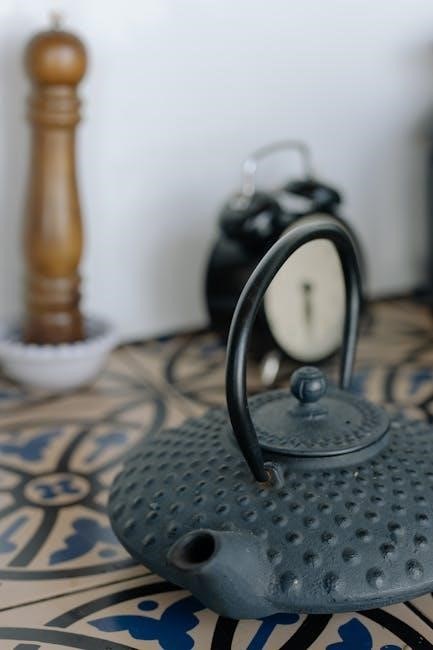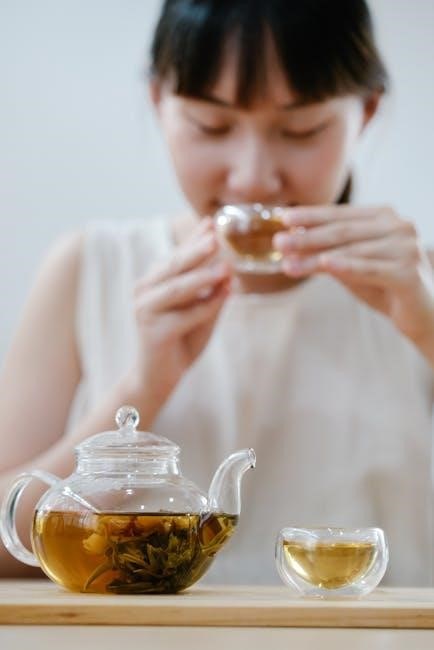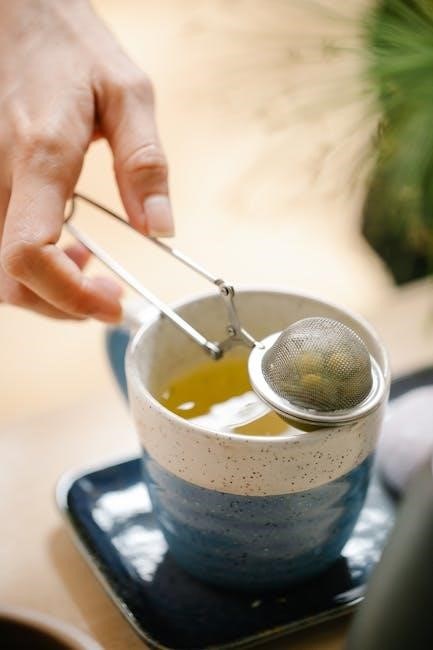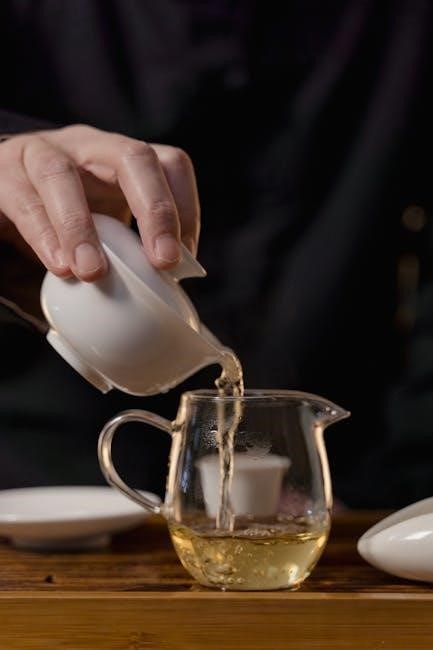
Brewing tea is an art and science that enhances flavor through precise techniques. Essential elements like tea leaves, water, temperature, and steeping time create a perfect cup. Explore tools and tips to master the process.

The Basics of Tea Brewing
Brewing tea starts with freshly drawn, filtered water, as impurities can affect flavor. Heat water to the ideal temperature for your tea type—black, oolong, and herbal teas thrive at 98°C, while green and white teas prefer 75-80°C. Use one teaspoon of loose-leaf tea per 250ml of water for black teas and slightly less for delicate varieties like green tea. Steeping times vary: 3-5 minutes for black teas, 2-3 minutes for green teas, and 5-7 minutes for herbal teas. Avoid over-steeping to prevent bitterness. Use a teapot or infuser to allow leaves to unfurl, releasing full flavor. Strain the tea into cups and enjoy immediately for optimal taste. Experiment with these basics to find your perfect cup, as personal preference plays a key role in the brewing process.
Why Temperature and Time Matter
Temperature and steeping time are crucial for extracting the perfect balance of flavors and aromas in tea. High temperatures can scorch delicate teas like green or white, leading to bitterness, while low temperatures may under-extract bold teas like black or oolong. Using boiling water for black tea ensures a robust flavor, whereas cooler water preserves the subtle nuances of green tea. Steeping time also affects the infusion—too short, and flavors remain undeveloped; too long, and the tea becomes astringent. The ideal steeping duration varies by tea type: 3-5 minutes for black, 2-3 for green, and 5-7 for herbal. Precision in these elements ensures a balanced and enjoyable cup, making temperature and time essential variables in mastering the art of tea brewing.

Understanding Tea Types
From black to green, oolong, white, and herbal, each tea type offers unique flavors and aromas shaped by processing methods. Understanding their differences ensures optimal brewing and appreciation of their distinct qualities.
Black Tea Brewing Tips
Black tea requires boiling water at 98°C and a steeping time of 3-5 minutes. Use one teaspoon of loose leaves per cup or one tea bag for a robust flavor. For a stronger brew, extend the steeping time slightly. To enhance the taste, add milk and sugar according to preference. Ensure water is freshly drawn and filtered for the best results. Proper brewing brings out the rich, bold characteristics of black tea, making it a satisfying choice for any time of day.
Green Tea Brewing Tips
Green tea thrives with water at 75°C and a steeping time of 1-3 minutes. Use one teaspoon of loose leaves per cup for optimal flavor; Avoid boiling water, as it can make the tea bitter. Steep briefly to preserve the delicate aroma and antioxidants. For a refreshing brew, let the tea leaves unfurl gently. Experiment with shorter steeping times for lighter notes or longer for bolder flavors. Use freshly drawn, filtered water to enhance the tea’s natural sweetness. Green tea is best enjoyed plain to appreciate its subtle nuances. This method ensures a balanced and satisfying cup every time.

Oolong Tea Brewing Tips
Oolong tea, partially fermented, requires precise brewing for optimal flavor. Use water at 98°C and steep for 2-5 minutes, adjusting based on roast level. Start with a quick rinse of the leaves, then brew in a gaiwan or Yixing teapot. Use one teaspoon of loose leaves per 8 oz of water. Multiple infusions are common, with up to 3-5 steepings. Longer roast oolongs can handle hotter water and more infusions. Delicate oolongs prefer shorter steeping times. Between infusions, pour hot water quickly to maintain temperature. This versatile tea can be enjoyed plain or with light snacks to enhance its complex floral and fruity notes. Experiment with steeping times to uncover the full depth of its flavor profile. Proper brewing technique brings out the smooth, silky texture oolong tea is known for, making it a rewarding experience for tea enthusiasts.
White Tea Brewing Tips
White tea, known for its delicate flavor, requires gentle brewing. Use water at 74°C to prevent bitterness, steeping for 2-3 minutes. Use one teaspoon of loose leaves per 8 oz of water. Delicate buds benefit from lower temperatures to preserve their subtle notes. Avoid over-steeping, as it can lead to astringency; Best brewed in a ceramic or glass teapot to avoid imparting unwanted flavors. Filtered water is ideal to ensure purity. Pair with light foods to complement its floral and honey-like notes. For iced white tea, steep in hot water, then chill. Experiment with steeping times to find your perfect balance. Proper brewing enhances the tea’s smooth, silky texture and subtle sweetness. Enjoy it plain to appreciate its refined character. White tea’s minimal processing makes it a delicate yet rewarding choice for those seeking a light, refreshing brew.
Herbal Tea Brewing Tips
Herbal teas, or tisanes, are caffeine-free infusions made from fruits, herbs, and flowers. To brew, use boiling water (98°C) and steep for 5-7 minutes. Use one tablespoon of loose herbs per 8 oz of water. Experiment with blends to create unique flavors. For floral herbs like chamomile, a shorter steeping time (3-5 minutes) preserves delicate notes. Fruit-based teas benefit from longer steeping to release vibrant flavors. Herbal teas are versatile and can be enjoyed hot or iced. Add honey or lemon to enhance taste. Use a glass or ceramic teapot to avoid chemical leaching. Perfect for any time of day, herbal teas offer calming and refreshing options. Customize blends to suit your mood or health needs. Store herbs in a cool, dark place to maintain potency. Herbal teas are a delightful, customizable choice for those seeking a caffeine-free, flavorful experience.
Choosing the Right Tools and Accessories
Selecting the right tools enhances your tea-brewing experience. Essential items include teapots, infusers, kettles, and storage containers. Quality tools help maintain flavor and ensure proper steeping for the best results.

Teapots and Infusers
Choosing the right teapot and infuser is crucial for optimal tea brewing. Teapots come in materials like ceramic, glass, or metal, each offering unique heat retention and flavor preservation benefits. Ceramic teapots are ideal for retaining heat, while glass allows you to monitor the steeping process visually. Metal teapots, such as those made from stainless steel, are durable and easy to clean. Infusers, whether built-in or separate, help contain loose tea leaves, ensuring even extraction. Opt for an infuser with fine mesh to prevent small particles from escaping. When selecting a teapot, consider its size to accommodate the number of servings you typically brew. A good teapot should also have a secure lid to prevent heat loss during steeping. Regularly wash and dry your teapot and infuser to avoid mold and residue buildup, ensuring fresh-tasting tea every time.

Strainers and Filters

Strainers and filters are essential tools for loose-leaf tea brewing, ensuring a smooth and particle-free experience. Metal strainers, often built into teapots or infusers, are durable and easy to clean, while silicone strainers are flexible and dishwasher-safe. Fabric filters, like cheesecloth or reusable cotton bags, are ideal for delicate teas, allowing subtle flavors to shine. When choosing a strainer, consider the size of the tea leaves and the mesh fineness to prevent sediment. Regular cleaning is crucial to avoid residue buildup, which can affect flavor. Rinsing your strainer before use ensures no lingering tastes. For herbal or flowering teas, larger mesh filters are recommended to accommodate expanding leaves. Investing in a quality strainer enhances both convenience and taste, making it a worthwhile addition to your tea setup. Proper maintenance and selection will elevate your brewing process and preserve the tea’s natural aroma and flavor. A clean, well-chosen strainer is key to a perfect cup.
Tea Cups and Mugs
Tea cups and mugs play a significant role in enhancing the tea-drinking experience. They come in various materials, each offering unique benefits. Ceramic cups are ideal for retaining heat and bringing out the full flavor of the tea, while glass cups allow for visual appreciation of the liquid’s clarity and color. Porcelain cups are a classic choice, known for their delicate beauty and even heat distribution. For a more casual setting, mugs made from sturdy materials like stoneware are both practical and comfortable to hold. The size of the cup is also important; smaller cups are better suited for strong, rich teas, while larger ones accommodate herbal or iced teas. Handles should be ergonomic for a comfortable grip, and rims should be wide enough for easy sipping. Aesthetics matter too, as the right cup can elevate the ambiance of your tea time. Selecting the perfect cup ensures a delightful and satisfying experience, complementing the tea’s aroma and taste. Choosing the right vessel is an essential part of the tea brewing process, making it a worthwhile investment for any tea enthusiast.
Kettles and Heat Sources
Kettles and heat sources are foundational tools in the tea-brewing process, ensuring water reaches the ideal temperature for your chosen tea. Electric kettles are popular for their speed and precision, often featuring variable temperature controls to suit different tea types. Stovetop kettles offer a traditional approach and are highly durable, while whistling kettles add convenience by signaling when water has boiled. For optimal results, use freshly drawn water, as stale or reused water can diminish the tea’s flavor. Heat sources like electric kettles provide consistent and quick heating, which is essential for achieving the perfect brew. Additionally, some kettles include keep-warm functions, allowing you to maintain the desired temperature for multiple infusions. Choosing the right kettle and heat source ensures efficiency and enhances the overall tea-drinking experience. Investing in a reliable kettle is a crucial step in mastering the art of tea brewing.
Storage for Tea Leaves
Proper storage for tea leaves is essential to preserve their flavor, aroma, and quality. Tea leaves are sensitive to light, heat, moisture, and oxygen, which can cause them to lose their potency and freshness. Store tea in airtight containers, such as glass jars or tin canisters, to protect them from air and light. Keep these containers in a cool, dark place, like a pantry or cupboard, away from direct sunlight and heat sources. Avoid storing tea near strong-smelling foods, as tea leaves can absorb odors easily. For optimal freshness, use the tea within six months to a year, depending on the type. Herbal and black teas generally have a longer shelf life, while green and white teas are more delicate and should be consumed sooner. Proper storage ensures your tea remains vibrant and flavorful for every brew.